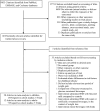Sugar-sweetened beverages and weight gain in children and adults: a systematic review and meta-analysis
- PMID: 23966427
- PMCID: PMC3778861
- DOI: 10.3945/ajcn.113.058362
Sugar-sweetened beverages and weight gain in children and adults: a systematic review and meta-analysis
Abstract
Background: The relation between sugar-sweetened beverages (SSBs) and body weight remains controversial.
Objective: We conducted a systematic review and meta-analysis to summarize the evidence in children and adults.
Design: We searched PubMed, EMBASE, and Cochrane databases through March 2013 for prospective cohort studies and randomized controlled trials (RCTs) that evaluated the SSB-weight relation. Separate meta-analyses were conducted in children and adults and for cohorts and RCTs by using random- and fixed-effects models.
Results: Thirty-two original articles were included in our meta-analyses: 20 in children (15 cohort studies, n = 25,745; 5 trials, n = 2772) and 12 in adults (7 cohort studies, n = 174,252; 5 trials, n = 292). In cohort studies, one daily serving increment of SSBs was associated with a 0.06 (95% CI: 0.02, 0.10) and 0.05 (95% CI: 0.03, 0.07)-unit increase in BMI in children and 0.22 kg (95% CI: 0.09, 0.34 kg) and 0.12 kg (95% CI: 0.10, 0.14 kg) weight gain in adults over 1 y in random- and fixed-effects models, respectively. RCTs in children showed reductions in BMI gain when SSBs were reduced [random and fixed effects: -0.17 (95% CI: -0.39, 0.05) and -0.12 (95% CI: -0.22, -0.2)], whereas RCTs in adults showed increases in body weight when SSBs were added (random and fixed effects: 0.85 kg; 95% CI: 0.50, 1.20 kg). Sensitivity analyses of RCTs in children showed more pronounced benefits in preventing weight gain in SSB substitution trials (compared with school-based educational programs) and among overweight children (compared with normal-weight children).
Conclusion: Our systematic review and meta-analysis of prospective cohort studies and RCTs provides evidence that SSB consumption promotes weight gain in children and adults.
Figures






Comment in
-
JPEN Journal Club 27: Vested Interests.JPEN J Parenter Enteral Nutr. 2017 May;41(4):691-693. doi: 10.1177/0148607117696329. JPEN J Parenter Enteral Nutr. 2017. PMID: 28445680 No abstract available.
Similar articles
-
Sugar-sweetened beverage consumption and weight gain in children and adults: a systematic review and meta-analysis of prospective cohort studies and randomized controlled trials.Am J Clin Nutr. 2023 Jan;117(1):160-174. doi: 10.1016/j.ajcnut.2022.11.008. Epub 2022 Dec 20. Am J Clin Nutr. 2023. PMID: 36789935
-
Beverage Consumption and Growth, Size, Body Composition, and Risk of Overweight and Obesity: A Systematic Review [Internet].Alexandria (VA): USDA Nutrition Evidence Systematic Review; 2020 Jul. Alexandria (VA): USDA Nutrition Evidence Systematic Review; 2020 Jul. PMID: 35349233 Free Books & Documents. Review.
-
Intake of sugar-sweetened beverages and weight gain: a systematic review.Am J Clin Nutr. 2006 Aug;84(2):274-88. doi: 10.1093/ajcn/84.1.274. Am J Clin Nutr. 2006. PMID: 16895873 Free PMC article. Review.
-
Sugar-Sweetened Beverages and Weight Gain in Children and Adults: A Systematic Review from 2013 to 2015 and a Comparison with Previous Studies.Obes Facts. 2017;10(6):674-693. doi: 10.1159/000484566. Epub 2017 Dec 14. Obes Facts. 2017. PMID: 29237159 Free PMC article.
-
Resolved: there is sufficient scientific evidence that decreasing sugar-sweetened beverage consumption will reduce the prevalence of obesity and obesity-related diseases.Obes Rev. 2013 Aug;14(8):606-19. doi: 10.1111/obr.12040. Epub 2013 Jun 13. Obes Rev. 2013. PMID: 23763695 Free PMC article. Review.
Cited by
-
Change in liking following reduction in sweetness level of carbonated beverages: a randomized controlled parallel trial.Sci Rep. 2024 Nov 5;14(1):26742. doi: 10.1038/s41598-024-77529-w. Sci Rep. 2024. PMID: 39500957 Free PMC article. Clinical Trial.
-
The Consumption of Non-Sugar Sweetened and Ready-to-Drink Beverages as Emerging Types of Beverages in Shanghai.Nutrients. 2024 Oct 19;16(20):3547. doi: 10.3390/nu16203547. Nutrients. 2024. PMID: 39458541 Free PMC article.
-
The link between the risk of cardiovascular diseases and the intake of different types of dietary carbohydrates in Iranian adults.Cardiovasc Endocrinol Metab. 2024 Oct 16;13(4):e00311. doi: 10.1097/XCE.0000000000000311. eCollection 2024 Dec. Cardiovasc Endocrinol Metab. 2024. PMID: 39430366 Free PMC article.
-
Ultraprocessed food intake and body mass index change among youths: a prospective cohort study.Am J Clin Nutr. 2024 Oct;120(4):836-845. doi: 10.1016/j.ajcnut.2024.07.024. Epub 2024 Aug 22. Am J Clin Nutr. 2024. PMID: 39362729
-
Effectiveness of a nutrition education intervention using simulation videos and encouragement of parental involvement for elementary school students.J Nutr Sci. 2024 Sep 19;13:e35. doi: 10.1017/jns.2024.41. eCollection 2024. J Nutr Sci. 2024. PMID: 39345240 Free PMC article.
References
-
- Yngve A, Haapala I, Hodge A, McNeill G, Tseng M. Making soft drinks the dietary version of the cigarette. Public Health Nutr 2012;15:1329–30 - PubMed
-
- Malik VS, Willett WC, Hu FB. Sugar-sweetened beverages and BMI in children and adolescents: reanalyses of a meta-analysis. Am J Clin Nutr 2009;89:438–9; author reply 9–40 - PubMed
Publication types
MeSH terms
Substances
Grants and funding
LinkOut - more resources
Full Text Sources
Other Literature Sources


